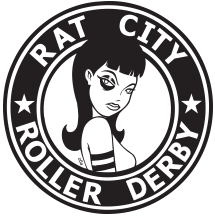
In April, we celebrate Earth Day with our partnership with our featured charity, Seattle Aquarium at the April 13th Bout at KeyArena, presented by Chinook Book! As part of this focus, we wanted to explore the athletes in their daily lives as they make extraordinary contributions in our local community. This month we introduce you to Kate, aka K. Beezy, Grave Danger‘s featured skater this month, and learn about her passionate work off the track, in her own words:
When talking about my job, most people pause and ask, “What exactly do you do for work?” This is mainly because one day, at the headwaters of a stream, conducting surveys of returning spawning Salmonid species and another I’ll be geared up in a wetsuit and mask, viewing fish in a way most don’t get the chance to, in their natural environment.Growing up in the beautiful state of Michigan, I spent most of my childhood outside– climbing trees, swimming in our pond, and camping in the Upper Peninsula of Michigan. I hated having ‘indoor’ chores– vacuuming and dishes– and would appreciate when I was asked to mow the lawn or clean the window screens. As long as I was outdoors and I was breathing fresh air, I was happy. I always felt drawn to our natural world, a certain calm when in the presence of nature, and was interested in how things work and why I became a natural scientist.
After receiving a Bachelors of Science from Michigan Technological University, I packed my bags and moved westward with the hope of working in my area of study, Environmental Science. Following an internship monitoring wetlands and a seasonal position at a hatchery, I was fortunate enough to be hired by my current employer, the Stillaguamish Tribe. The Natural Resources Department focuses on all things environmental encompassed within the Stillaguamish River watershed; my focus is Fisheries Management.

Besides working outdoors regularly, I feel very in touch with the natural world because my annual work cycle is completely driven by the life cycle of the Salmon. My tasks and projects rely on the specific real time activities of the fish– my favorite time of the year is just after summer when the air starts to get crisp. The Salish Sea Indians, ancestors of the Stillaguamish Tribe, didn’t have ‘seasons’
but they referred to this time as when the white butterflies appeared. The importance of these butterflies appearing was that it meant that the Salmon were returning to their spawning grounds and to the Indians, a great food source.
Currently, Stillaguamish Chinook are listed as threatened on the Endangered Species Act List; their populations are suffering and need help, which is coordinated through fish hatchery management and habitat restoration. My co-workers and I spend a few weeks in August in the river “broodstocking” for returning Salmon– a process in which we collect live adults and transfer them back to the hatchery to be spawned. The process of broodstocking is a beautiful dance of controlled chaos as we use seine nets in a freshwater river system. I gear up in a wetsuit, mask and snorkel and help ensure that our nets don’t get caught on any snags, to help lead the line, pull the nets, and coerce the fish into our net. Despite all the chaos that is surrounding me and the net, there is this moment right before we begin fishing when I’m underwater viewing a hundred or so 15-20 pound Chinook swimming gracefully in strong currents. This gives me an overwhelming pride in my work and my efforts in rebuilding and maintaining this population of salmon.

After we finish broodstocking, I spend some of my days hiking and surveying 4-5 mile stretches of the river for spawning ground redds (where they lay their eggs) and carcasses. We collect samples of tissue, scales and retrieve heads containing implanted Coded Wire Tags from Hatchery Brood. Handling and sampling a decaying fish carcass may not sound like a dream job to most, but with
Whitehorse Mountain in the background, the sounds of water cascading, and the sun on your face– you get used to it pretty quickly. It doesn’t seem like work when you’re slathering on sunscreen, listening to some music on your MP3 player and walking on a beautiful river that you’ve dedicated your time and energy to restoring and preserving.
Another favorite part of my job is educating our community through the Stillaguamish Outreach Education Program. Whether it be days spent in a salt marsh talking about different ecosystems, or time at the hatchery showing the spawning process and stressing habitat conservation, I love that I get to teach others about being good stewards to their environment in a fun, hands-on way. An added bonus is that I can educate the public about the history of the Stillaguamish Tribe and their efforts in preserving and protecting the watershed.
Every day that I go to work is my own personal Earth Day — rain or shine, I get to enjoy the beauty of what our natural world has to offer us and assist in the preservation, restoration, and education of the Stillaguamish River. Planting trees, spawning fish, or testing water quality– it’s all for the future health of the watershed and the people within it.
